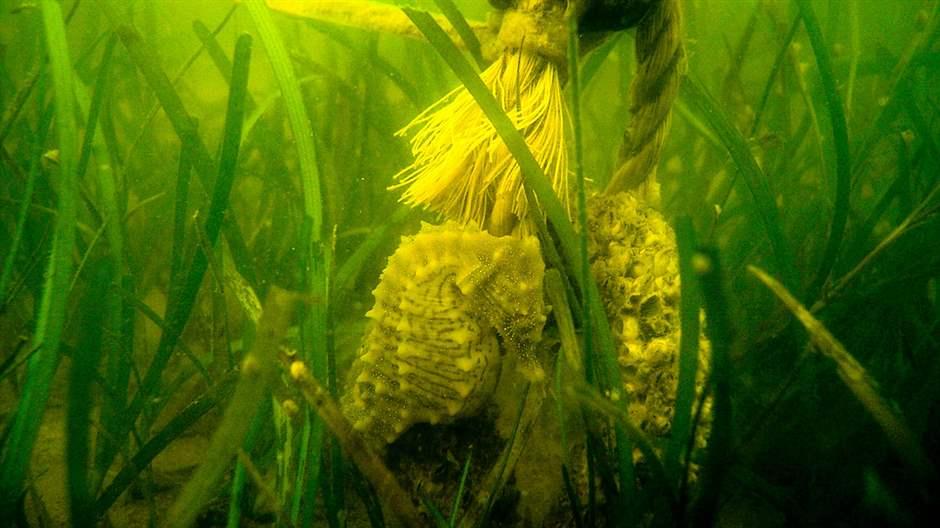How to Save U.S. Coasts: Transforming Climate Research into Action
Published on by Water Network Research, Official research team of The Water Network in Case Studies
Pew webinar highlights research on slowing climate change and improving fisheries

A lined seahorse, whose population is decreasing because of declining coastal habitats, rests at a screw anchor in seagrass off Maryland’s coastline. Maryland is one of six mid-Atlantic states included in recent research by Duke University’s Nicholas Institute for Environmental Policy Solutions about how intact habitats boost coastal resilience and climate change mitigation.
Mike Naylor Maryland Department of Natural ResourcesU.S. coastal communities—home to almost 40% of the country’s population and nearly one-third of its businesses—face a growing threat from sea level rise and increasingly intense storms fueled by climate change. Two coastal habitats proven to help to protect coasts, salt marsh and seagrass, are in alarming decline because of climate change and development.
Earlier this spring, The Pew Charitable Trusts’ Conserving Marine Life in the United States project hosted a webinar on how states can better conserve coastal ecosystems, which in turn will help boost community resilience to climate change and improve those ecosystems’ capacity to capture and store carbon. The webinar, attended by more than 160 federal and state officials, academics, and conservationists, featured presentations on North Carolina’s Coastal Habitat Protection Plan (CHPP) and how it could inform coastal conservation, climate adaptation, and resilience efforts in other states as well.
Jennifer Browning
Jennifer Browning, director of Pew’s conserving marine life in the United States project, discusses the institution’s goal of helping states develop policy to conserve habitats and leverage blue carbon to better protect their coasts.
Panelists also discussed a model adapted by Duke University’s Nicholas Institute for Environmental Policy Solutions to map coastal carbon capture and storage—known as blue carbon—and existing coastal protection, which was then applied in states from New York to North Carolina. The research sought to determine whether habitats such as North Carolina’s expansive salt marsh meadows and seagrass beds can protect shorelines from climate impacts including severe storms and increased erosion while also storing blue carbon.
North Carolina leads the pack in blue carbon potential
Of the six states studied in Duke’s mapping work—Delaware, Maryland, New York, New Jersey, North Carolina, and Virginia—the Tar Heel State had the greatest estimated baseline carbon storage and sequestration, Katie Warnell, a Nicholas Institute policy associate, told webinar attendees. She added that all six states are well positioned to include blue carbon and coastal resilience in conservation plans. “These are places where you could do relatively small projects and end up with a relatively large carbon benefit and get a really good bang for your buck,” Warnell said, referring to coastal wetland restoration opportunities identified in the research that could enhance blue carbon.
Maintaining coastal habitats into the future in the face of rising seas can also provide benefits such as keeping blue carbon from being disturbed, said Lydia Olander, director of the Ecosystem Services Program at the Nicholas Institute. This would probably involve protecting key coastal habitats such as North Carolina’s pocosin forests while preserving open space in other areas to allow salt marsh to migrate inland away from rising seas.
Lydia Olander
Lydia Olander, director of the Ecosystem Services Program at Duke University’s Nicholas Institute for Environmental Policy Solutions, discusses ways in which states can support resiliency and prevent carbon release from their coastal habitats.
CHPP was created to aid fisheries
North Carolina’s CHPP originated out of concerns by fisheries officials about declining fish stocks, habitat health, and water quality, increased fish kills and algae blooms, more frequent closures of shellfish harvest areas, and growing coastal development, said Casey Knight, coastal habitats biologist with the North Carolina Division of Marine Fisheries.
Casey Knight
Casey Knight, a coastal habitats biologist with the North Carolina Division of Marine Fisheries, discusses the commercial, recreational, and cultural value of fishing in North Carolina.
Beyond their commercial, recreational, and cultural benefits, North Carolina’s coastal habitats also reduce wave energy and erosion rates 50% to 80%, which benefits property owners, Knight said. Economists, for example, estimate the average 30-year storm protection value of healthy habitats in North Carolina’s 22 coastal counties at $1.3 million per kilometer. In addition, wetlands are “kind of like living sponges,” she said, capable of storing up to 300,000 gallons of water per acre per day, “which can drastically reduce the flooding in towns and the [pollution] runoff into the water.”
The interagency CHPP—completed in 2005 and revised every five years by the North Carolina Department of Environmental Quality—connects a diverse range of governmental and nongovernmental entities and identifies research needs, said panelist Chris Baillie, a postdoctoral researcher with the Gittman Coastal Ecology Lab at East Carolina University. Pew is working with managers, scientists, and stakeholders in North Carolina to increase protections for seagrass and salt marsh and improve water quality in an updated CHPP scheduled for completion at the end of 2021.
Chris Baillie
Chris Baillie, a postdoctoral researcher with the Gittman Coastal Ecology Lab at East Carolina University, explains the urgent need for an ambitious, integrated approach to save coastal wetlands.
States committed to improving the resilience of their coasts and mitigating climate change should follow North Carolina’s lead by conducting and incorporating evidence-based research on how to restore and conserve their coastal habitats, including salt marsh and seagrass meadows.
View the full 90-minute webinar recording here.
Taxonomy
- Coastal Engineering
- Coastal